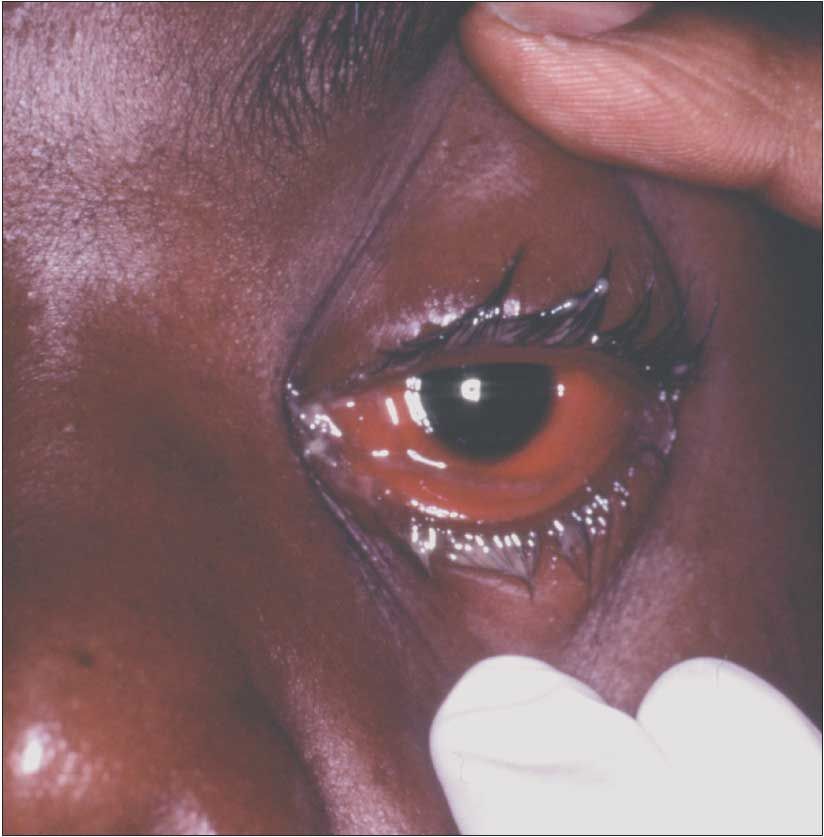- Clinical Technology
- Adult Immunization
- Hepatology
- Pediatric Immunization
- Screening
- Psychiatry
- Allergy
- Women's Health
- Cardiology
- Pediatrics
- Dermatology
- Endocrinology
- Pain Management
- Gastroenterology
- Infectious Disease
- Obesity Medicine
- Rheumatology
- Nephrology
- Neurology
- Pulmonology
Young Man With Swelling and Purulent Discharge in His Left Eye and Urethral Discharge
A 25-year-old man reports that he has had a swollen eye for thepast several days. He noticed a small amount of yellow discharge the previousevening. He denies systemic complaints, including fever, chills, nausea, vomiting,and recent trauma. He also tells you that he has a drip in my private area.

THE CASE: A 25-year-old man reports that he has had a swollen eye for the past several days. He noticed a small amount of yellow discharge the previous evening. He denies systemic complaints, including fever, chills, nausea, vomiting, and recent trauma. He also tells you that he has a “drip in my private area.”
Which of the following most accurately describes the patient's condition?
•Simple bacterial conjunctivitis with associated incidental urethritis.
•Behet syndrome.
•Primary gonococcal urethritis with secondary gonococcal bacterial conjunctivitis.
Answer and discussion on next page.
ANSWER: Primary gonococcal urethritis with secondary gonococcal bacterial conjunctivitis
DISCUSSION:Neisseria gonorrhoeae, a highly infectious gram-negative diplococcal organism (Figure 1), causes a purulent inflammation that can affect almost any mucous membrane. Each year, more than 650,000 new gonococcus (GC) infections occur in the United States and approximately 200 million are reported worldwide.
Presentation and complications. GC infection follows sexual and perinatal transmission. The most common clinical presentation involves infection of the lower genital tract: urethritis in men (Figure 2) and endocervicitis in women. Infections in other areas-such as the pharynx, rectum, and female urethra-occur frequently but are less likely to be symptomatic than genital infections.
Complications in women include pelvic inflammatory disease with endometritis, salpingitis, and tubo-ovarian abscess. Rarely, retrograde spread may eventuate in abdominal peritonitis or a perihepatitis known as Fitz- Hugh–Curtis syndrome. In men, epididymitis or epididymo-orchitis may develop. In both sexes, lower genital infection becomes a risk factor for other sexually transmitted diseases, including HIV. Accidental self-inoculation by finger may cause a secondary gonococcal bacterial conjunctivitis that is usually unilateral.
In neonates, ophthalmia neonatorum (bilateral conjunctivitis) usually follows vaginal delivery by an infected mother. Symptoms of GC conjunctivitis include redness, eye discomfort, and a purulent discharge. Prompt recognition and treatment are essential to avoid blindness, which may occur very quickly. In the United States and other countries where neonatal prophylaxis is routine, blindness from GC conjunctivitis is uncommon, although it continues to be a serious problem in developing nations. Blindness after adult GC conjunctivitis also occurs with greater frequency in these areas.
Long-term sequelae. Chronic pelvic pain in women after pelvic inflammatory disease, septic abortion, chorioamnionitis in pregnancy, and infertility in both sexes are the most common long-term sequelae of gonorrhea. Ectopic pregnancy is a life-threatening complication that may follow infection and secondary scarring of the reproductive tract. Meningitis or endocarditis may follow disseminated infection. Although GC infections are most frequently seen in adolescents and young adults, sexual abuse must be considered in any child who presents with a GC infection.
Treatment. Cultures from likely sites of infection are indicated. Treatment may be begun if GC infection is strongly suspected and/or Gram stain results are positive. The regimen may be adjusted once culture results have been obtained. Initiate antibiotic therapy (eg, ceftriaxone, 1 g IM) as quickly as possible, along with saline lavage. Hospitalization is recommended for patients with corneal involvement. Administer ceftriaxone, 1 g IV every 12 to 24 hours. A topical regimen of ofloxacin, ciprofloxacin, gentamicin, or tobramycin every hour is recommended; alternatively, topical ciprofloxacin drops every 2 hours or bacitracin ointment 4 times daily can be used.
In patients allergic to penicillin, a single oral dose of ofloxacin, 400 mg, or ciprofloxacin, 500 mg, may be used. Fluoroquinolones are contraindicated in children and pregnant women.
Include coverage for chlamydia because of the high incidence of concomitant chlamydial infection. Suggested regimens are oral doxycycline, 100 mg twice daily for 10 days, or tetracycline or erythromycin, 250 to 500 mg twice daily for 14 days.
Ophthalmologic consultation is imperative in any patient with GC conjunctivitis because blindness may occur if the disease process is not treated aggressively. Treatment of the patient’s sexual partner(s) is important to prevent reinfection and complications, as well as to avoid medicolegal problems. Hospitalization is recommended for unreliable or incompetent patients.
FOR MORE INFORMATION:
- Centers for Disease Control and Prevention. Sexually transmitted diseases treatment guidelines 2002. MMWR. 2002;51(RR-6):1-80.
- Fox KK, Whittington WL, Levine WC, et al. Gonorrhea in the US, 1981-1996: demographic and geographic trends. Sex Transm Dis. 1998;25:386-393.
- Sherrard J. Modern diagnosis and management of gonorrhoea. Br J Hosp Med. 1996;55:394-398.
